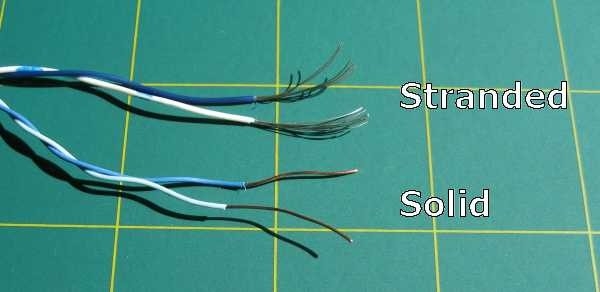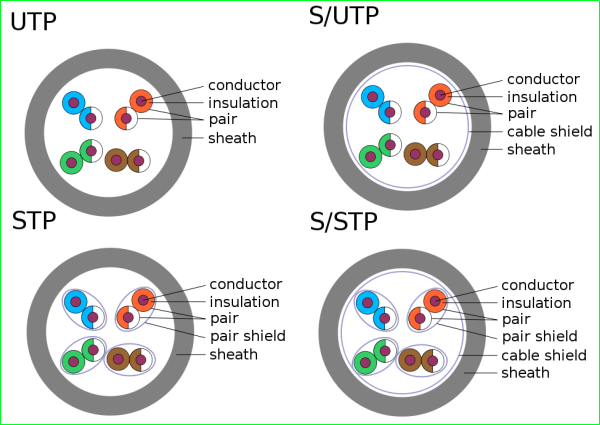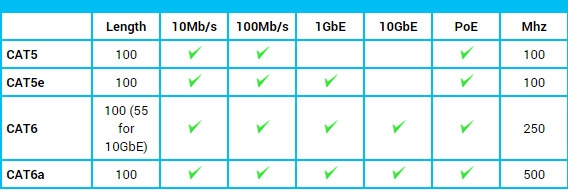CAT5, CAT5e and CAT6, all of these are twisted-pair copper cable that is used to carry signals. They are most often used in computer networks, but can also be used to move data in home theatre applications. Every cable on the market has product standards set by the Telecommunication Industry Association and the Electronic Industries Association. These three cables have very similar guidelines and differ mostly in their performance level.
CAT5–Category 5 cable is the current standard in high-speed internet, it is capable of transmitting information 10x faster than CAT 3. CAT 5 cable is available in two varieties: unshielded twisted pair (UTP), which is more sensitive to EMI and screened twisted pair (SCTP), which provides more protection against EMI. The UTP version is widely used in the US, while the SCTP is rarely used outside of Europe. CAT5 can carry data up to 100 Mbit/s (12.5 MB/s) with possible bandwidth of 100MHz (100 million cycles per second). Cat 5 is rated at 100-BaseT. CAT 5 cables are solid or stranded. Solid Cat 5 Cable is rigid: used for long distances, whereas stranded CAT5 Cables are flexible: used for patching.

- Stranded cable is more flexible and should be used at your desk or anywhere you may be moving the cable around often.
- Solid cable is not as flexible but it is also more durable which makes it ideal for permanent installations as well as outdoor and in walls.
More about the UTP, STP and SCTP

CAT5e (CAT 5e, Category 5, enhanced) – Category 5, enhanced has the same specifications of basic CAT 5 cable however, it can handle data transfers up to 1000Mbps (1Gb/s). It is suitable for Gigabit Ethernet, and is less susceptible to near-end cross talk (Next) , the interference between two pairs in a cable measured at the same end of the cable as the interfering transmitter. Next is usually caused by crossed or crushed wire pairs.
- current technology (enhanced)
- less sensitive to EMI, electromagnetic interference
- reduced Next, near-end cross talk
- data transfer up to 1000 Mbit/s (1Gb/s)
- rated for 1000-BaseT
- comes in solid or stranded
CAT6 – Category 6 cable – is a more advanced version of the listed cables, it’s performance exceeds its predecessors. CAT6 is made up of four twisted pairs of copper by a longitudinal separator, a structure that isolates each of the four pairs from each other. The separator reduces crosstalk, allows for faster data transfer, and twice the bandwidth of Cat5. CAT6 supports Gigabit Ethernet, and can operate up to 250Mhz (250 million cycles per second). CAT6 is backwards compatible, can support exisiting CAT5 and CAT5e cabling. CAT 5 is rated for 1000BASE-T.
- advanced current technology
- less sensitive to EMI, electromagnetic interference
- reduced Next, near-end cross talk
- data transfer up to 1000 Mbit/s (1Gb/s)
- supports Gigabit Ethernet
- comes in solid or stranded
Cat5e vs. Cat6

CAT Technical differences: CAT5 vs. CAT5e vs. CAT6 vs. CAT6a

Read more tips about the Ethernet Cables, CAT Technical & Physical Differences



















































































































